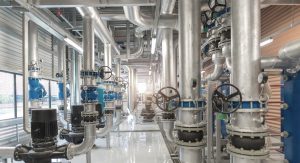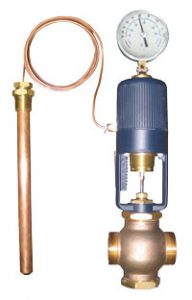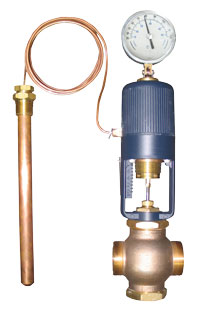 There are several reasons why a 38R is a great choice in your heating or cooling applications, with the most obvious being that there is no power required. The 38R temperature regulator is a fully self-contained unit, requiring no external power source. This could mean substantial savings over the operation of other types of valves.
There are several reasons why a 38R is a great choice in your heating or cooling applications, with the most obvious being that there is no power required. The 38R temperature regulator is a fully self-contained unit, requiring no external power source. This could mean substantial savings over the operation of other types of valves.
Regulation takes place when the sensing bulb is exposed to changes in temperature. The thermal system is charged with a predetermined amount of vapor fill, which, when heated, will cause a bellows within the unit’s actuator housing to expand. As the bellows expands, it compresses a return spring while simultaneously moving the valve stem downward to stroke the valve.
When the process temperature decreases or in the event of thermal system failure, the return spring will move the valve stem upward to the “out” position.
Another clear advantage is that the 38R temperature regulator is “self operating.” In other words, it is a “set-and-forget” regulating device. Once the control point setting has been achieved, the unit requires virtually no adjustments and very little maintenance.
So, are there any drawbacks to a 38R valve? Yes, and we’ll explain.

First 38R 3-way valves are not designed for use in steam applications.
“Self-acting” temperature regulators are not intended for use in applications where the media comes in direct contact with the skin or body, such as showers, baths, or lavatories. They are also not intended for use with sudden or large load changes, or where rapid temperature changes occur. In those cases, a pneumatically or electrically powered control valve should be specified. Additionally, temperature regulators are not considered close-off valves. A pressure surge may force a single seated valve plug open. The temperature regulator is a balanced equilibrium system and provides no power to tightly seat the valve plug. A separate power driven or hand actuated valve is required to ensure tight close-off when necessary.
Our “self-acting” 38R temperature regulator is recommended for controlling the flow on relatively stable systems, where small valve stroke modulations will correct temperature drift, and should be carefully selected to meet the demands of the particular application.
If you have any questions, the Dwyer Applications Engineers are available to assist by phone at (219) 879-8000 x6402, or by email at tech@dwyermail.com.

